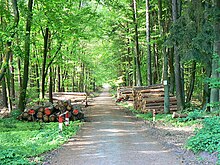A forest product is any material derived from forestry for direct consumption or commercial use, such as lumber, paper, or fodder for livestock. Wood, by far the dominant product of forests, is used for many purposes, such as wood fuel (e.g. in form of firewood or charcoal) or the finished structural materials used for the construction of buildings, or as a raw material, in the form of wood pulp, that is used in the production of paper. All other non-wood products derived from forest resources, comprising a broad variety of other forest products, are collectively described as non-timber forest products (NTFP).[1][2][3] Non-timber forest products are viewed to have fewer negative effects on forest ecosystem when providing income sources for local community.[4]
Globally, about 1,150,000,000 ha (2.8×109 acres) of forest is managed primarily for the production of wood and non-wood forest products. In addition, 749,000,000 ha (1.85×109 acres) is designated for multiple use, which often includes production.[5]
Worldwide, the area of forest designated primarily for production has been relatively stable since 1990, but the area of multiple-use forest has decreased by about 71,000,000 ha (180,000,000 acres).[5]

- ^ Belcher, B. M. (2005-06-01). "Forest product markets, forests and poverty reduction" (PDF). International Forestry Review. 7 (2): 82–89. doi:10.1505/ifor.2005.7.2.82. hdl:10170/476. ISSN 1465-5489. S2CID 54083558.
- ^ Ticktin, T. (2004). "The ecological implications of harvesting non-timber forest products". Journal of Applied Ecology. 41 (1): 11–21. doi:10.1111/j.1365-2664.2004.00859.x. ISSN 1365-2664.
- ^ Belcher, Brian; Schreckenberg, Kathrin (2007). "Commercialisation of Non-timber Forest Products: A Reality Check" (PDF). Development Policy Review. 25 (3): 355–377. doi:10.1111/j.1467-7679.2007.00374.x. ISSN 1467-7679. S2CID 154953328. Archived from the original (PDF) on 2022-01-20. Retrieved 2019-09-19.
- ^ Endress, Bryan A.; Gorchov, David L.; Noble, Robert B. (2004). "Non-timber forest product extraction: effects of harvest and browsing on an understory palm". Ecological Applications. 14 (4): 1139–1153. doi:10.1890/02-5365. JSTOR 4493611.
- ^ a b Global Forest Resources Assessment 2020 – Key findings. Rome: FAO. 2020. doi:10.4060/ca8753en. ISBN 978-92-5-132581-0. S2CID 130116768.